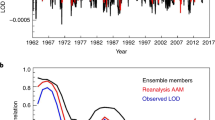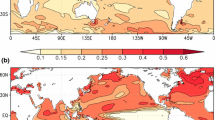Abstract
To assess whether trends in the troposphere's circulation have occurred this century in concert with changes at the surface, we consider the low-frequency behavior in the global angular momentum of the atmosphere. Values of this index have been computed each month since 1870 from model experiments conducted by the UK Hadley Centre for Climate Prediction and Research, in which the model atmosphere is driven by prescribed boundary forcings, most especially sea surface temperature (SST) fields. The interannual variability of the model's atmospheric angular momentum compares favorably with that derived from the NCEP/NCAR reanalysis for the period of overlap (the second half of the twentieth century). Evidence is found for a notable increase in interannual variability since around 1970, but this recent high level of variability may not be significantly greater than that during 1900–1920. This latter result is strongly dependent on the character of the SST field used in an experiment, because low-frequency signals in atmospheric momentum are closely linked to those in the El Niño/Southern Oscillation. Large differences exist, however, among SST estimates in the tropical Pacific for the early part of the century.
Similar content being viewed by others
Author information
Authors and Affiliations
Additional information
Received: 8 July 1999 / Accepted: 2 February 2000
Rights and permissions
About this article
Cite this article
Rosen, R., Salstein, D. Multidecadal signals in the interannual variability of atmospheric angular momentum. Climate Dynamics 16, 693–700 (2000). https://doi.org/10.1007/s003820000076
Issue Date:
DOI: https://doi.org/10.1007/s003820000076




